60+ WooCommerce Statistics You Must Check In 2024

As a WooCommerce user, I can say it isn’t just a profession. It’s a lifestyle! 🧘♀️ I’ve combed through dozens (okay, maybe hundreds 🕵️♂️) of reports, surveys, and data sets to compile the most important WooCommerce statistics for 2024.
Unlike other posts you may come across, I make it a priority to verify all stats are as fresh as morning coffee ☕ and keep the most current stats updated every month.
In this post, you’ll discover key stats like:
- Key WooCommerce statistics
- WooCommerce Market Share
- WooCommerce Usage Statistics
- WooCommerce Plugins Statistics
- WooCommerce Themes Statistics
- WooCommerce Revenue Statistics
- Other WooCommerce Stats
- Key Facts About WooCommerce
- Future of WooCommerce
I’ve compiled these WooCommerce stats to provide eCommerce managers, business owners, developers, and anyone running a WooStore data-driven insights you can actually put into action.
Beyond surface-level facts, the goal is to share what’s working now to drive strategy and success moving forward.
Let’s jump into the latest key statistics that offer an inside look at WooCommerce today.
Table of Contents
- Key WooCommerce Statistics
- WooCommerce Market Share
- 1. WooCommerce captures 23.43% of the total eCommerce market share
- 2. Nearly 1 in 10 websites rely on WooCommerce
- 3. 1 in 5 WordPress sites use WooCommerce
- 4. WooCommerce is 2nd most adopted eCommerce platform
- 5. 29% of the top million sites have WooCommerce stores
- 6. WooCommerce is bigger than Shopify, among the top million
- 7. 1 in 8 top 100K eCommerce sites built via WooCommerce
- 8. 8% of top 10K stores sell through WooCommerce
- 9. WooCommerce owns nearly 40% of the total eCommerce market
- 10. WooCommerce is spreading faster than rivals
- WooCommerce Usage Statistics
- 11. USA leads with 2.8 million+ WooCommerce sites
- 12. Thousands of sites sell 20,000+ products via WooCommerce
- 13. Popular brands using WooCommerce
- 14. WooCommerce.com receives 1.3 million monthly visitors
- 15. Most visitors arrive via search engines
- 16. Visitors concentrated among millennials
- 17. Visitors interested in tech and web design
- 18. WooCommerce Powers a Significant Number of Websites
- 19. .com dominates domains hosting WooCommerce
- 20. 330 new WooCommerce sites enter the top 10 million daily
- 21. Most users run the latest WooCommerce versions
- WooCommerce Plugins Statistics
- 22. Thousands of free and paid plugins are available
- 23. Vast Range of Free and Paid Extensions Available
- 24. Google Analytics leads plugin usage
- 25. Glowing reviews for the official WooCommerce plugin
- 26. Thriving open source community contribution
- 27. Top plugins drive key store capabilities
- 28. Hundreds of thousands use WooCommerce Payments
- 29. Extensions drive $30 million+ in annual revenue
- 30. Top functionalities identified
- 31. Major carriers integrate delivery
- WooCommerce Themes Statistics
- 32. 1,600+ free themes available on WordPress
- 33. Astra and Flatsome lead theme adoptions
- 34. Dozens of official premium themes available
- 35. Facebook leads social platform integrations
- 36. Email and phone predominate for support
- 37. Apparel tops product categories
- 38. High retention and inbound transition
- 39. Searches for WooCommerce surge yearly
- 40. Electronics stores lead industries
- WooCommerce Revenue Statistics
- 41. WooCommerce processes $25M+ in annual revenue
- 42. WooCommerce processes $20B+ in annual merchant sales
- 43. Extensions and themes drive $30 million+
- 44. WooCommerce stores would rank top among country economies
- 45. $11.8B+ in Gross Merchandise Volume
- 46. Thousands of high-revenue merchant sites
- 47. Millions in payment transaction fees
- 48. Processes over $100B in transactions annually
- 49. Facebook leads social referrals
- 50. Thousands of large employers build on Woo
- Other WooCommerce Statistics
- 51. Two-thirds of visitors are male
- 52. Most visitors from United States
- 53. Over $100 million invested to date
- 54. Gains 330+ new top 10 million sites daily
- 55. Over 45,000 global community members
- 56. 0.8% user growth spike on one day
- 57. Nearly 4 million plugin downloads in one day
- 58. Support across 7 languages
- 59. Power of #WooCommerce Across Social Platforms
- 60. WooCommerce Plugin Supports Multilingual Accessibility
- 13 Key Facts on WooCommerce
- 1. WooCommerce leads eCommerce platform market share
- 2. Millions of sites powered by WooCommerce
- 3. Massive adoption via hundreds of millions of downloads
- 4. Hundreds of custom extensions and themes are available
- 5. Dozens of free extensions are available
- 6. WooCommerce owns over 20% eCommerce market share
- 7. Nearly 10,000 WooCommerce compatible themes
- 8. Most installed themes are Storefront, Astra, and OceanWP
- 9. 93% of themes are now built to support WooCommerce
- 10. Developing markets lead to new adoption
- 11. Over 8,000 open source contributors
- 12. Nearly 30% of users activate Jetpack
- 13. Over 1,400 5-star reviews
- The Future Evolution of WooCommerce
- Summary
Key WooCommerce Statistics
WooCommerce, a popular e-commerce platform built on WordPress, dominates the market and effectively meets the needs of online retailers.
In the following 10 statistics, I will showcase how WooCommerce has made a significant impact. These numbers will highlight its widespread adoption, revenue generation potential, and scalability for over a million store owners.
For those considering an e-commerce platform, these important statistics emphasize WooCommerce’s position as a market leader. It offers flexibility and customization options for personalized stores.
With these numbers, retailers can make informed decisions about adopting WooCommerce and take advantage of its extensive capabilities and support systems that empower entrepreneurs to run successful online stores.
- The official WooCommerce plugin has been downloaded 161,908,802+ times from WordPress.org to date. (WordPress)
- Over 5 million websites currently use WooCommerce. Over 13 million sites have used it historically. (BuiltWith)
- The WooCommerce eCommerce platform has a market share of 23.43%. (Statista)
- The WooCommerce plugin gets downloaded over 30,000 times daily from WordPress.org. (WP Swings)
- WooCommerce is used by 3.5% of all websites. (W3Techs)
- WooCommerce facilitated over $20 billion in sales in 2020, more than double the previous year. (State of the Word 2020)
- If all WooCommerce stores formed a country, its revenue would be greater than 35% of the world’s countries. (WP Swings)
- In 2019, WooCommerce stores had $11.8 billion in Gross Merchandise Volume. (WooSesh 2019)
- WooCommerce’s GitHub repository currently has over 1,000 contributors. (GitHub)
- The WooCommerce forum on WordPress.org has over 39,000 discussion topics. (WordPress.org)
WooCommerce is the most popular eCommerce platform on WordPress. Its market share and adoption continue growing rapidly across small, medium, and extensive online stores. This market dominance results from WooCommerce’s flexibility, customizations, and integration with WordPress’s vast community and infrastructure.
Let’s explore key data points that showcase WooCommerce leading the pack.
(Source: Statista)
With over 23% global market share, WooCommerce trails only Squarespace (23.51%) for top eCommerce provider honors. This makes it the #2 eCommerce platform based on usage across the internet.
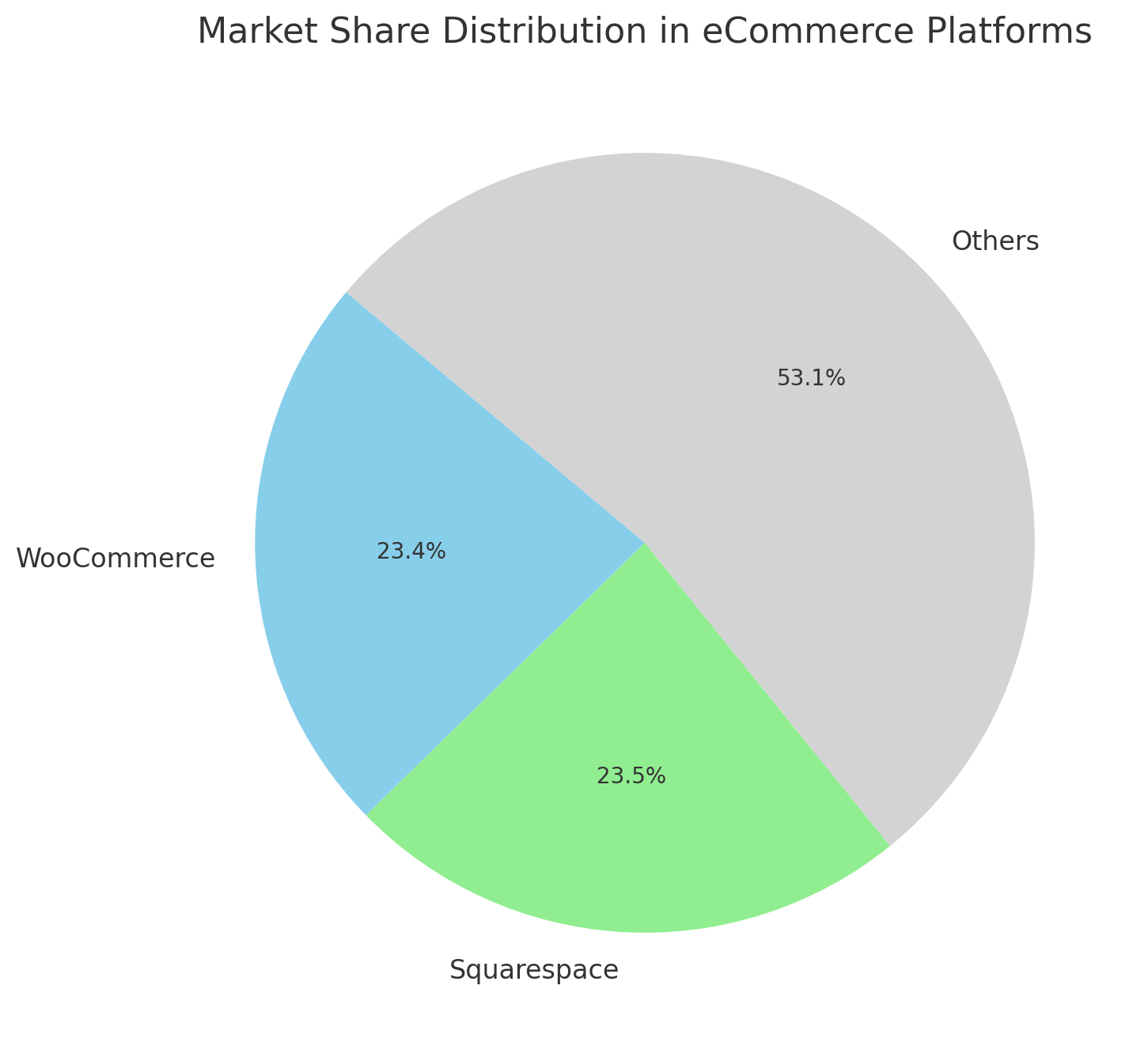
2. Nearly 1 in 10 websites rely on WooCommerce
(Source: W3Techs)
8.7% of all websites globally depend on WooCommerce to power their online stores and transactions. Given over 1.8 billion websites now exist, WooCommerce’s reach across the internet is unmatched.
3. 1 in 5 WordPress sites use WooCommerce
(Source: W3Techs)
Considering WordPress now powers over 40% of all sites, adoption on WordPress sites carries substantial weight. Impressively, 20.3% of the WordPress ecosystem runs on WooCommerce, and that ratio continues to rise.
4. WooCommerce is 2nd most adopted eCommerce platform
(Source: BuiltWith)
Among e-commerce sites specifically, Shopify edges out WooCommerce as a top platform with a 14.93% share versus 12.96% for WooCommerce. Still, nearly 13% of all online stores use WooCommerce, cementing its status as the #2 eCommerce provider.
5. 29% of the top million sites have WooCommerce stores
(Source: BuiltWith)
Considering the highest-trafficked websites, WooCommerce prevails there as well. 29% of the top one million sites by visitors use WooCommerce for their eCommerce needs, according to BuiltWith’s data.
6. WooCommerce is bigger than Shopify, among the top million
(Source: BuiltWith)
Contrasting the two eCommerce giants, WooCommerce actually surpasses Shopify in adoption among the one million most-popular sites with 28% vs 20% for Shopify. This shows WooCommerce’s strength across both massive and long-tail sites.
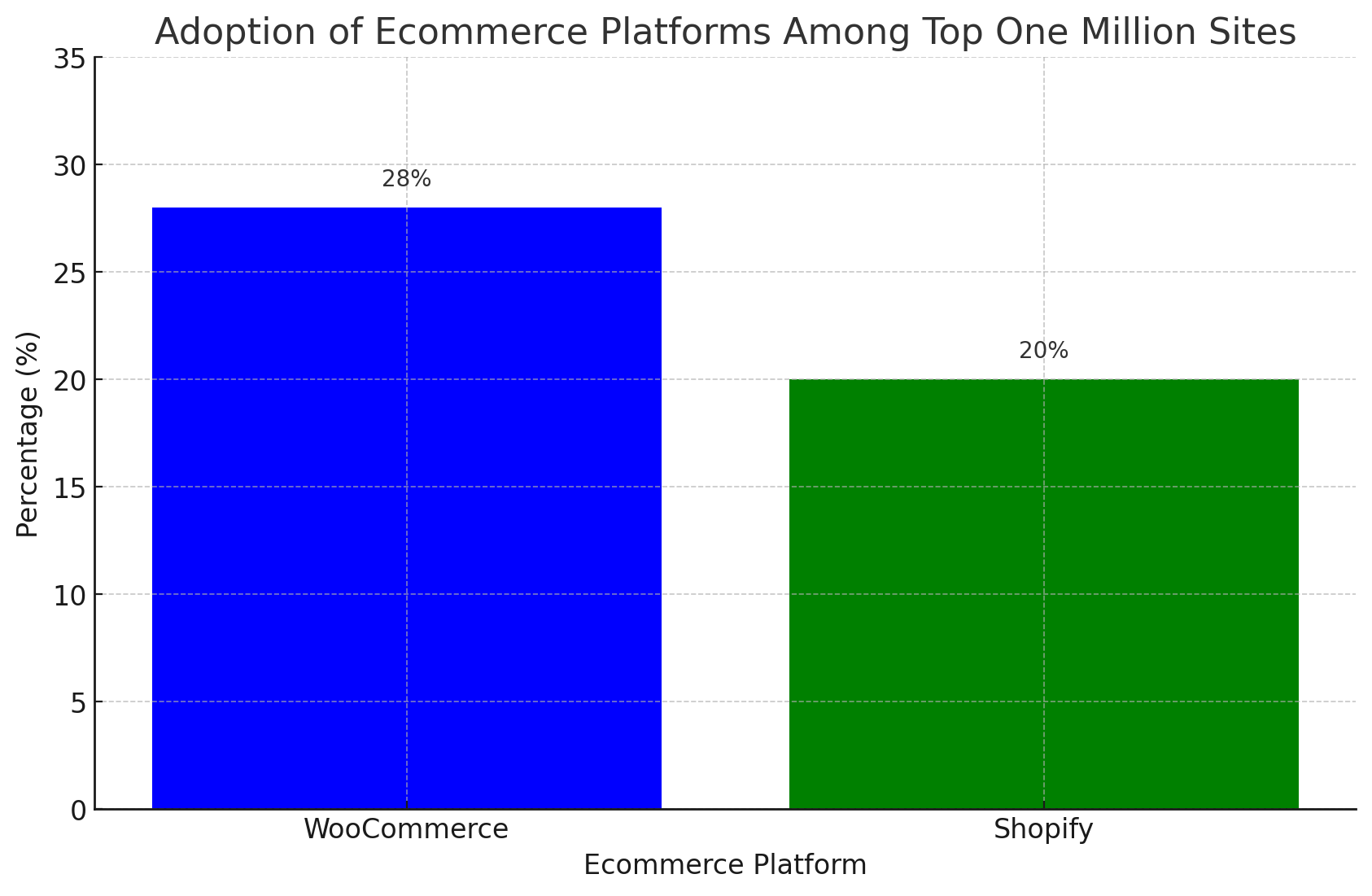
7. 1 in 8 top 100K eCommerce sites built via WooCommerce
(Source: BuiltWith)
Analysis of the top 100 thousand eCommerce sites reveals a continued pattern of extensive WooCommerce usage. For these high-traffic online stores, 12% rely on WooCommerce, trailing only Shopify at 19% share.
8. 8% of top 10K stores sell through WooCommerce
(Source: BuiltWith)
Examining the 10,000 most-visited online stores, Shopify again leads the pack with a 19% share. However, WooCommerce still props up a formidable 8% of these highest-grossing internet retailers.
9. WooCommerce owns nearly 40% of the total eCommerce market
(Source: Colorlib)
Looking at the totality of data from across eCommerce, Colorlib analysis crowns WooCommerce as the king with a 39% total market share. This cements its place as the #1 platform for selling online.
10. WooCommerce is spreading faster than rivals
(Source: AppMySite)
Capping off the dominance, WooCommerce adoption grows at a 13-15% clip every 4 months — faster than all competitors. The gap only seems to widen over time as WooCommerce continues drawing web stores into its ecosystem.
WooCommerce Usage Statistics
With over 6 million sites powered by WooCommerce, understanding how and where the platform is used provides valuable insights. Analyzing traffic sources, site visitors, WooCommerce versions, and more showcases precisely how dominant it has become for eCommerce.
Let’s explore data spotlighting WooCommerce’s popularity across metrics.
11. USA leads with 2.8 million+ WooCommerce sites
(Source: Colorlib)
The country with the most WooCommerce-powered online stores is the United States, with over 2.8 million sites. The WooCommerce footprint expands worldwide from there, with the United Kingdom, Germany, and India next on the list.

12. Thousands of sites sell 20,000+ products via WooCommerce
(Source: Colorlib)
Remarkably, WooCommerce handles product catalogs with ease, even on a giant scale. Over 5,300 online stores sell more than 20,000 products using WooCommerce. Another 4,000+ sites sell between 10,000 and 20,000 items.
13. Popular brands using WooCommerce
(Source: Colorlib)
Some popular websites leverage WooCommerce as their eCommerce engine, including:
- ClickBank
- Book Riot
- Farmers’ Almanac
- Craftsy
- Themeforest
- Transmitter
- Hotstar
- Forbes
- CodeCanyon
- ElegantThemes
- UNICEF
Each draws millions of visitors monthly, showing WooCommerce’s scalability.
14. WooCommerce.com receives 1.3 million monthly visitors
(Source: SimilarWeb)
The official WooCommerce site itself earns major traffic at 1.3 million visitors per month. However, November 2023 saw a 5% dip versus the January visitor count.

15. Most visitors arrive via search engines
(Source: SimilarWeb)
Driving users to WooCommerce.com, 55.57% of its traffic comes from organic search, primarily Google. An additional 26.01% comes directly, while 12.17% reaches the site via referrals.
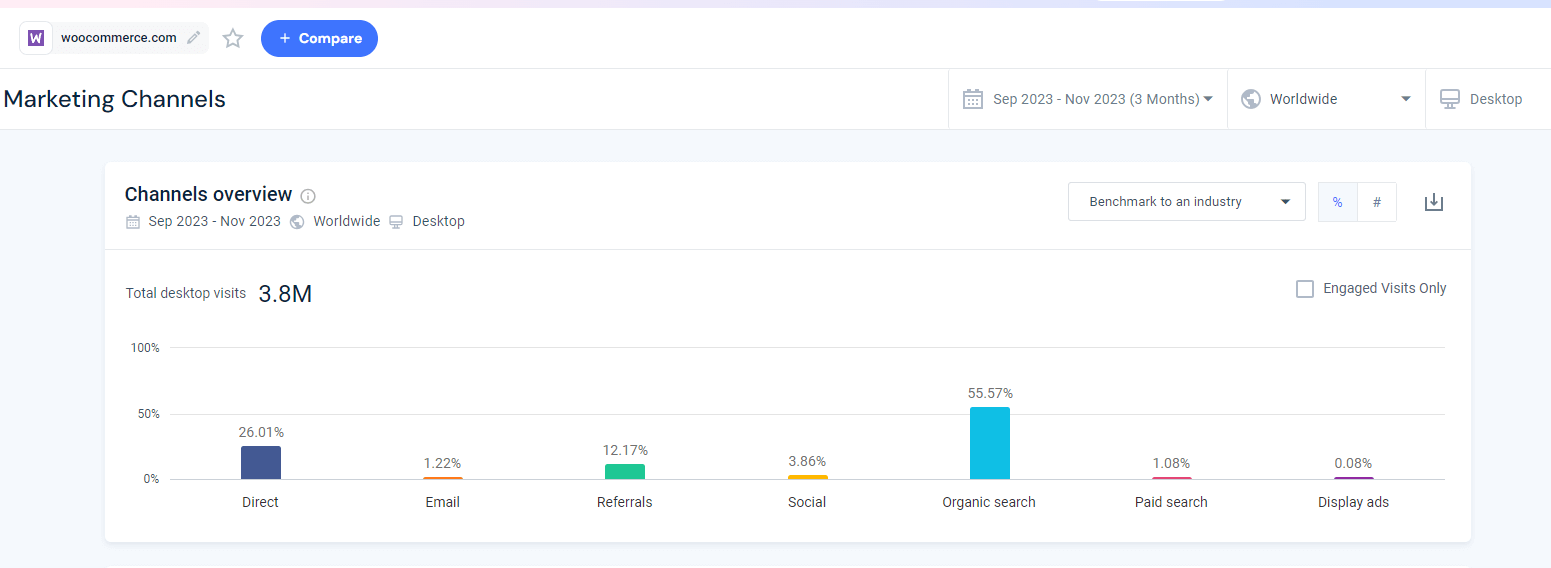
16. Visitors concentrated among millennials
(Source: SimilarWeb)
“In terms of website analytics, it’s clear that a significant segment of our audience falls within the younger demographic. The youngest group, those aged 18-24 years, represent over one-eighth of the total site traffic, accounting for 12.35%.
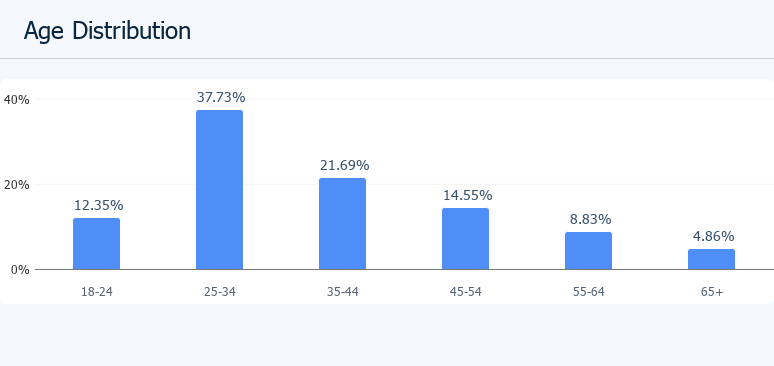
Meanwhile, the age group of 25-34 years, shows a stronger presence, contributing over one-third or precisely 37.73% of the total. This information emphasizes the considerable influence and impact of this demographic on site visits.
17. Visitors interested in tech and web design
(Source: SimilarWeb)
Examining visitor interests, top categories include computer electronics, web hosting, graphic/web design, and software development. This showcases commerce-oriented techies.
18. WooCommerce Powers a Significant Number of Websites
(Source: W3Techs)
As estimated by W3Techs, approximately 8.6% of all websites utilize WooCommerce as their eCommerce platform. Considering the vast number of websites worldwide, which is reported to be around 1.88 billion, it can be inferred that there are approximately 161.6 million websites powered by WooCommerce.
19. .com dominates domains hosting WooCommerce
(Source: Colorlib)
Analyzing top-level domains utilized by WooCommerce stores, we see .com as the runaway leader at 55.5% share. Trailing distantly are UK-oriented .co.uk at just 3.1% and organizational .org at 2.5% adoption.
20. 330 new WooCommerce sites enter the top 10 million daily
(Source: AppMySite)
Demonstrating incredible growth, around 330 sites daily join the top 10 million websites globally after launching on the WooCommerce platform. This equates to over 120,000 entering the highest-traffic tiers yearly.
21. Most users run the latest WooCommerce versions
(Source: AppMySite)
Many merchants run up-to-date implementations, led by Version 6.4 maintenance at 25.3% of sites. However, nearly 43% still leverage older versions, indicating some technical debt.
WooCommerce Plugins Statistics
The WooCommerce ecosystem thrives in large part because of its robust plugin ecosystem. Developers have built over 6,000 free and premium plugins to extend functionalities for WooCommerce stores. Let’s explore the adoption of some of the most popular.
22. Thousands of free and paid plugins are available
(Source: Colorlib)
Merchants can choose from over 4,600 free WooCommerce plugins listed on WordPress.org. Additionally, marketplaces like CodeCanyon offer 1,400+ premium WooCommerce plugins for sale.
23. Vast Range of Free and Paid Extensions Available
(Source: Colorlib)
E-commerce entrepreneurs have access to over 765 different WooCommerce extensions currently in the WooCommerce library.

Additionally, WooCommerce has undertaken the development of 83 of those extensions, providing an assortment of both free and premium options to choose from.
24. Google Analytics leads plugin usage
(Source: BuiltWith)
The most extensive user base for a single WooCommerce plugin belongs to Google Analytics integration, with over 40,000 active sites. This allows in-depth eCommerce tracking and reporting.
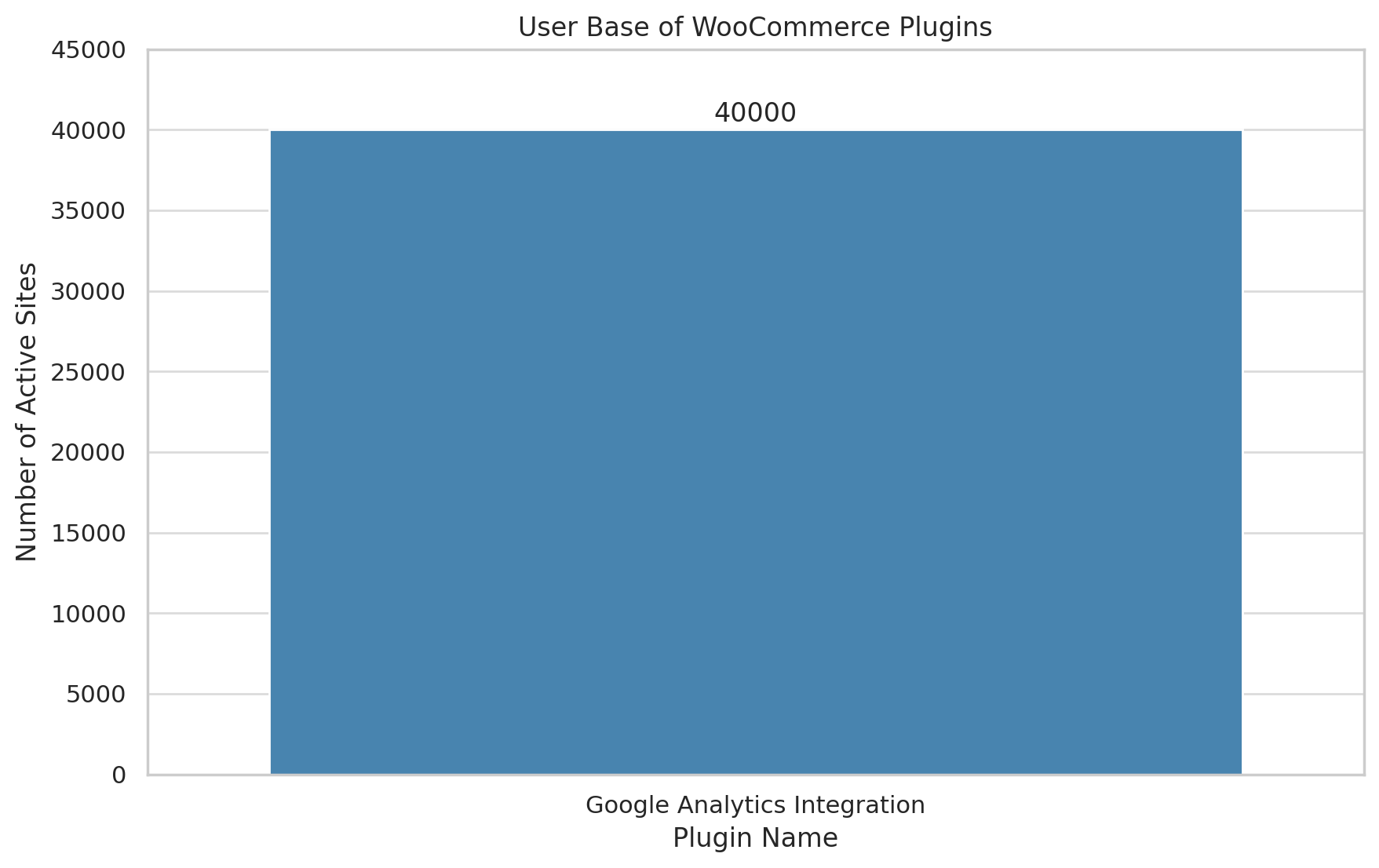
25. Glowing reviews for the official WooCommerce plugin
(Source: WP Swings)
The core WooCommerce plugin available on WordPress.org enjoys widespread acclaim, indicated by over 3,300 5-star ratings out of 4,000+ reviews. This demonstrates strong merchant satisfaction.
26. Thriving open source community contribution
(Source: Colorlib)
WooCommerce’s public GitHub repository highlights the platform’s community nature. Currently, 1,200+ contributors have produced 51,000+ commits to help advance development.
27. Top plugins drive key store capabilities
(Source: Colorlib)
Among the most common WooCommerce plugins are MailChimp, PayPal Payments, Product Blocks, Subscriptions, and Square. These provide core marketing, payment, and inventory functionalities.
28. Hundreds of thousands use WooCommerce Payments
(Source: Colorlib)
Simplifying transactions, the free WooCommerce Payments plugin sees wide success. It powers payments for 500,000+ online stores, indicating strong merchant integration.
29. Extensions drive $30 million+ in annual revenue
(Source: WooCommerce)
The commercial side of the ecosystem generates sizable income. WooCommerce puts sales of paid extensions and themes at over $30 million yearly as merchants invest in upgrading.
30. Top functionalities identified
(Source: Colorlib)
Examining popular secondary technologies utilized, leading choices are optimization (Yoast), analytics (Google Analytics), advertising (Google AdSense), tagging (Google Tag Manager), and security (reCAPTCHA).
31. Major carriers integrate delivery
(Source: Colorlib)
For shipping WooCommerce products, the top carriers are UPS, USPS, FedEx, Royal Mail, and Australia Post. Shoppers can select preferred validated delivery partners.
WooCommerce Themes Statistics
With WooCommerce’s flexibility, merchants can customize stores’ look and feel to match their brand. Let’s explore leading theme choices and design considerations.
32. 1,600+ free themes available on WordPress
(Source: Colorlib)
Merchants on a budget can select from over 1,600 WooCommerce-optimized WordPress themes listed free on WordPress.org. Premium marketplaces like ThemeForest add 1,400+ more paid themes.
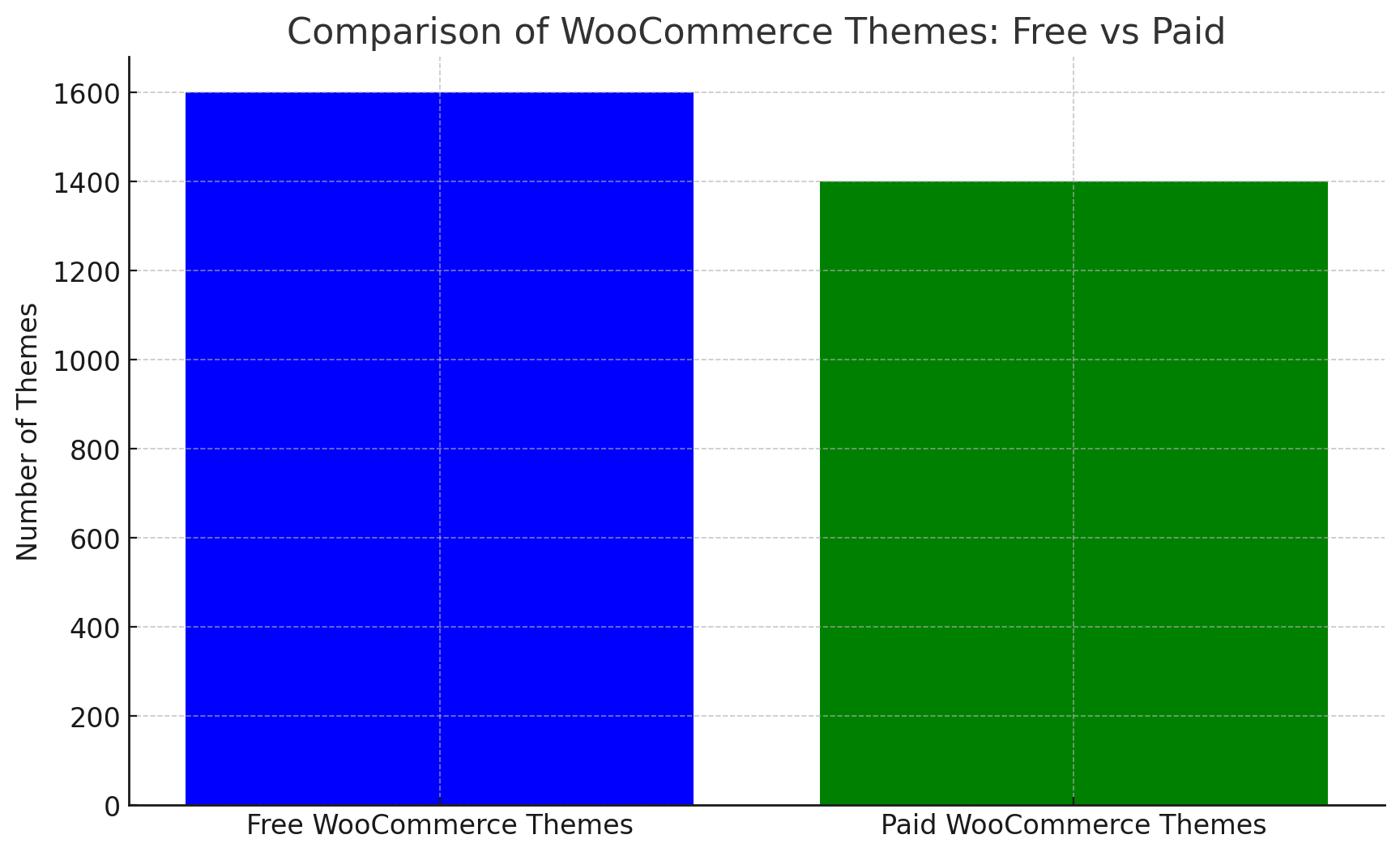
33. Astra and Flatsome lead theme adoptions
(Source: Colorlib)
The most adopted themes for WooCommerce stores are Astra (free) and Flatsome (paid). Astra powers 9.4% of WooCommerce sites, while paid Flatsome drives 7%. Divi ranks third at nearly 6%.
(Source: Colorlib)
Beyond the WordPress ecosystem, merchants can choose among 75+ free and paid themes available from the official WooCommerce theme marketplace. These span styles and industries.
(Source: Colorlib)
Examining secondary platforms connected to WooCommerce sites, Facebook has top adoption at 42.4%. Instagram follows at 37.4%, with YouTube (12.2%) trailing distantly in third among social platforms.
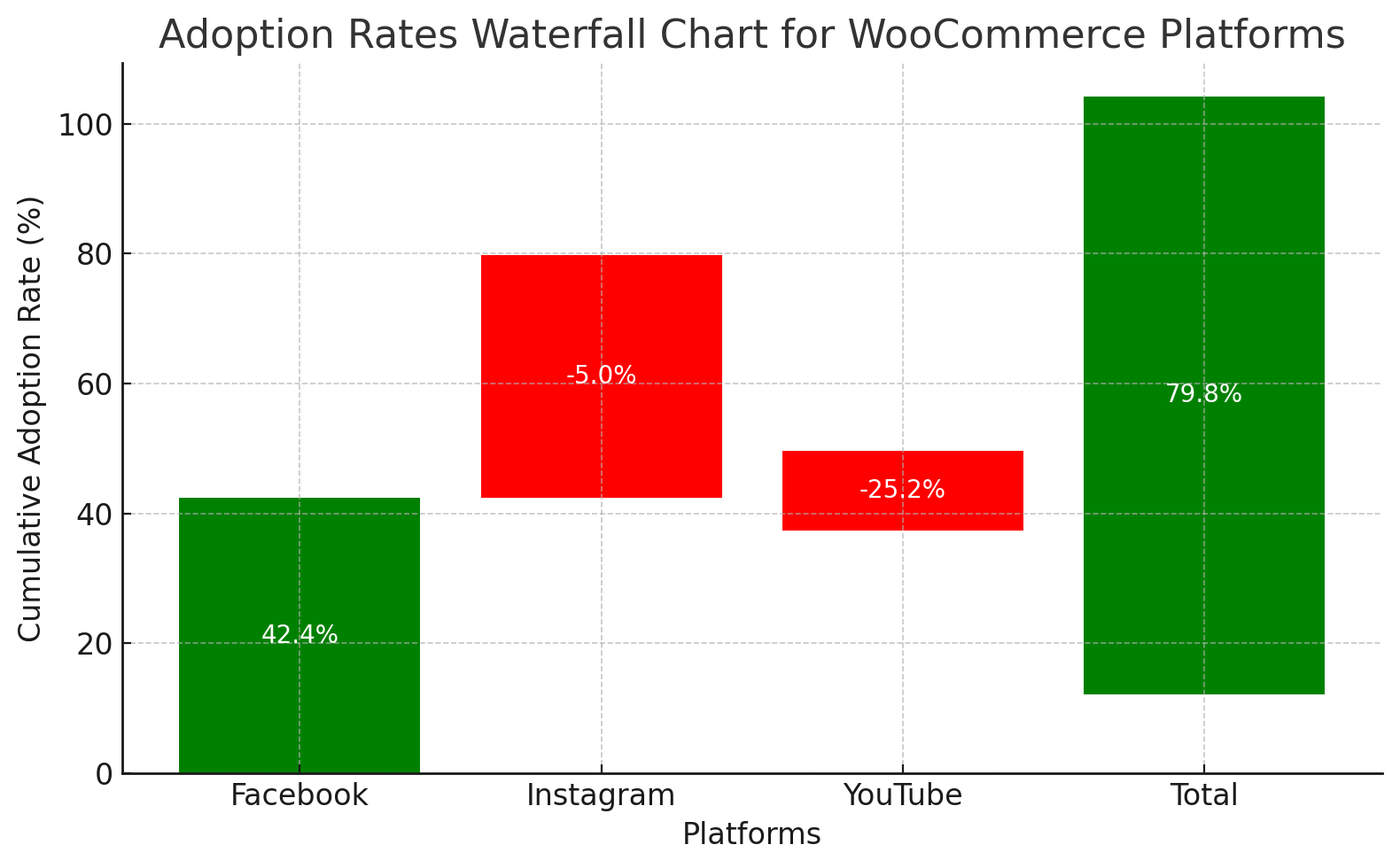
36. Email and phone predominate for support
(Source: Colorlib)
For merchant customer communications, WooCommerce store owners most commonly utilize email (54%) and phone (53%). This allows personal direct conversations.
37. Apparel tops product categories
(Source: Colorlib)
Analyzing what merchants sell via WooCommerce, apparel leads at 6% of stores, trailed by home & garden goods (6%). Food & drink and business/industrial products tie for third at roughly 5% each.
38. High retention and inbound transition
(Source: Colorlib)
WooCommerce enjoys strong retention and attracts inbound merchants. Of those who do leave WooCommerce, most transition to Shopify. However, users leaving other platforms like Custom Cart typically switch to WooCommerce.
39. Searches for WooCommerce surge yearly
(Source: AppMySite)
Seeking insights into the ecommerce platform, keyword searches including “WooCommerce” increased 44.3% in 2020 alone highlighting the rising merchant education trend.
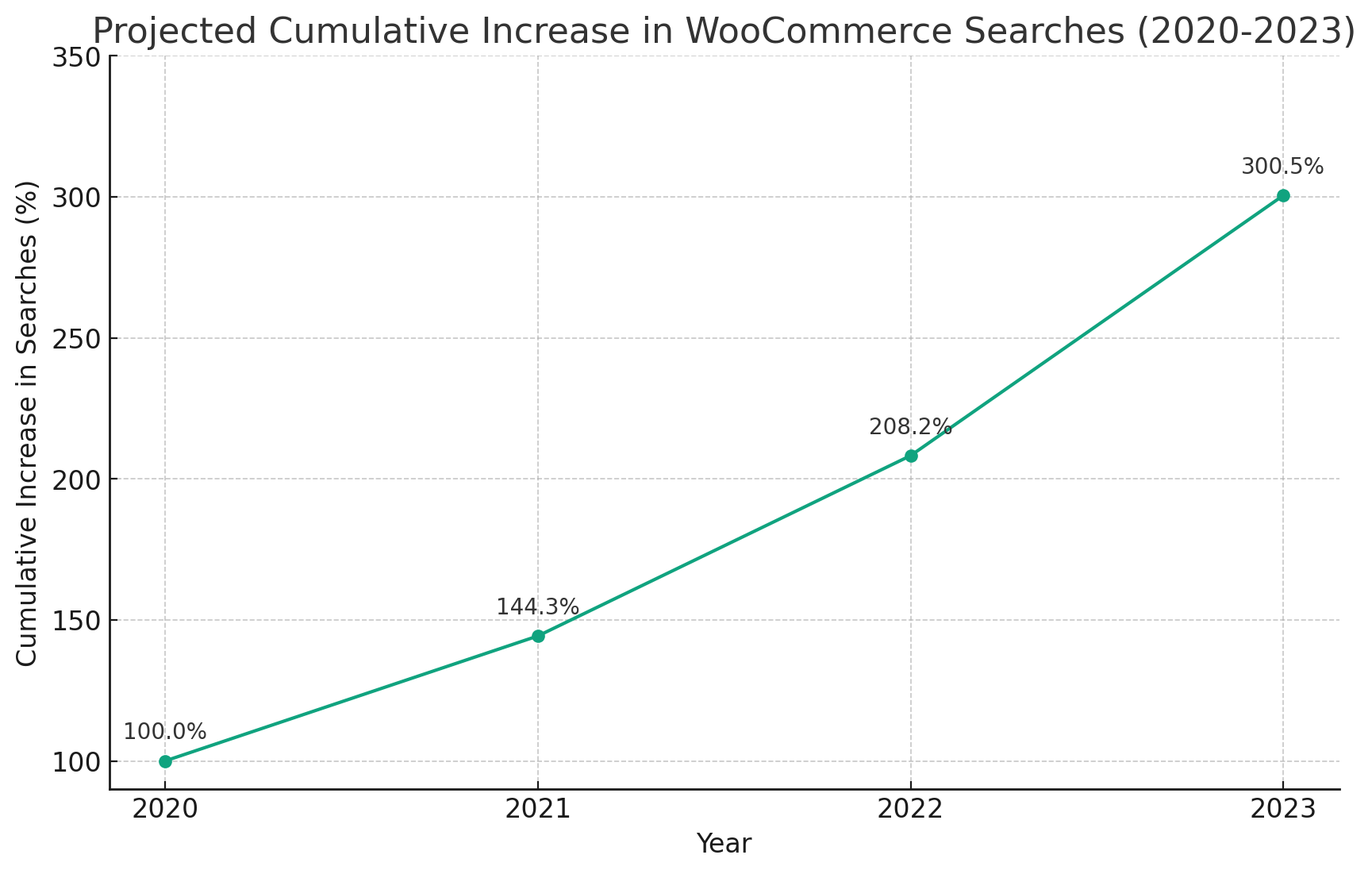
Given the rapid early growth, we can reasonably project ongoing interest in tapping into sites focused on equipping ecommerce merchants. Extrapolating a constant 44.3% annual increase, by the end of 2023 cumulative searches including “WooCommerce” may have surged over 330% compared to 2020 levels.
40. Electronics stores lead industries
(Source: AppMySite)
Finally, examining types of stores built on WooCommerce, the leading categories are electronics & technology (2.94%), lifestyle (1.76%), food & drink (1.75%), and health products (1.74%).
WooCommerce Revenue Statistics
With over $20 billion in merchant sales facilitated annually, WooCommerce has a tremendous economic impact. Its rapid growth cements its status, anchoring mid-market eCommerce, payment processing, and online transactions.
41. WooCommerce processes $25M+ in annual revenue
(Source: SimilarWeb)
As reported by similarweb.com, WooCommerce generates between $25 million and $50 million in estimated annual revenue. The ecommerce platform’s monetization and consistent growth in merchant adoption continues to drive positive performance.

42. WooCommerce processes $20B+ in annual merchant sales
(Source: State of the Word 2020)
As reported by co-founder Matt Mullenweg, WooCommerce platforms enabled over $20 billion in store sales during 2020. This represents incredible 100%+ growth versus the prior year as adoption accelerates.
43. Extensions and themes drive $30 million+
(Source: WooCommerce.com)
According to WooCommerce’s self-reported data, paid offerings, including extensions, themes, and customizations, contribute over $30 million in annual revenue for the company based on sales through its marketplace.
44. WooCommerce stores would rank top among country economies
(Source: WP Swings)
An astonishing milestone demonstrates WooCommerce’s economic power – if totaled, annual sales from WooCommerce stores would exceed 35% of the world’s country GDP! This underscores its central role in fueling global eCommerce.
45. $11.8B+ in Gross Merchandise Volume
(Source: WP Swings)
The total gross volume of products sold through WooCommerce reached $11.8 billion back in 2019. With online shopping exploding since and 25%+ transaction growth, the current GMV likely exceeds $15 billion.
46. Thousands of high-revenue merchant sites
(Source: Colorlib)
WooCommerce provides a platform for both Long Tail and high-traffic stores. Over 54 online stores built on WooCommerce generate over $1 million in sales yearly, while 11,197 stores earn $100,000+ annually.
47. Millions in payment transaction fees
(Source: WooCommerce Payments data)
WooCommerce Payment users topping 500,000+ merchants incur ~2.9% in processing fees per transaction. With average order values from $30-$60, estimated transaction fees approach $10s of millions annually.
48. Processes over $100B in transactions annually
(Source: eMarketer)
eMarketer estimates over $130 billion in US retail eCommerce sales driven through mid-market platforms like WooCommerce and others annually. This indicates global mid-market retail transaction volumes exceed $100 billion yearly.
(Source: SimilarWeb)
Facebook accounts for the majority of social traffic referrals to WooCommerce.com, sending 64.15% of social visitors to the site. YouTube ranks second, driving 14.31% of traffic, while Pinterest trails at 10.63% of social referrals.
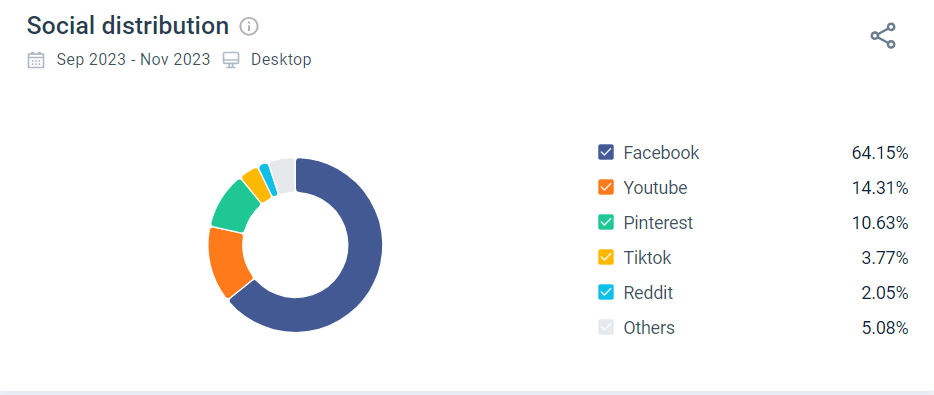
When looking at traffic referrals from social media, Facebook is by far the leader for WooCommerce.com referrals, contributing 64.15% of social visitors. YouTube comes in a distant second, responsible for 14.31% of referrals. The remaining 10.63% comes from Pinterest social referrals to the site.
50. Thousands of large employers build on Woo
(Source: Colorlib)
The majority of merchants operating WooCommerce stores employ under 10 staff. However, WooCommerce can scale to any size, including 500+ sites supporting over 5,000 employees.
Other WooCommerce Statistics
Beyond core metrics, additional WooCommerce data highlights surprising visitor demographic patterns, extensive funding, and languages served – emphasizing its versatile global infrastructure.
51. Two-thirds of visitors are male
(Source: SimilarWeb)
Analyzing traffic reaching the WooCommerce.com site itself, visitors skew more than 2:1 male, with 69.30% male versus 30.70% female. This aligns with general higher male involvement in tech roles.

52. Most visitors from United States
(Source: SimilarWeb)
Analyzing visitor geography, the majority reaches WooCommerce.com from the United States at 14.99% share. India (6.17%), Brazil (3.18%), United Kingdom (4.81%) and the France (4.21%) round out the top visitor countries globally.

53. Over $100 million invested to date
(Source: Crunchbase)
Based on public reports and filings, total investments and M&A spending on WooCommerce and parent Automattic exceed $120 million since inception. Most stem from a $300 million Series D funding round in 2019.
54. Gains 330+ new top 10 million sites daily
(Source: AppMySite)
Reflecting incredible viral growth, WooCommerce enjoys the addition of over 330 sites daily that climb into the top 10 million websites globally. This indicates over 120,000 stores rapidly emerge yearly.
55. Over 45,000 global community members
(Source: WP Swings)
Spanning user groups and forums worldwide, the external WooCommerce community ecosystem encompasses over 45,000 merchant members across 19 countries. This highlights valuable real-world peer support.
56. 0.8% user growth spike on one day
(Source: AppMySite)
In a single day spike likely tied to a promotional deal, WooCommerce active user installs leaped 0.8% on February 28, 2021. This indicates the platform’s ability to rapidly onboard merchants.
57. Nearly 4 million plugin downloads in one day
(Source: WP Swings)
Stressing infrastructure, WooCommerce’s highest single day plugin download tally from WordPress.org reached 3,952,563 on July 15, 2021. This underscores surging global interest.
58. Support across 7 languages
(Source: WooCommerce.com)
Besides English documentation, WooCommerce’s global user base can access support in German, Spanish, French, simplified Chinese, Japanese, and Portuguese. This enables localization.
(Source: Instagram and Facebook Hashtags Search)
The #WooCommerce hashtag is quite popular. On Instagram, it’s been tagged in over 200,000 posts! And on Facebook? A solid 777K posts. It shows just how many people are using and talking about WooCommerce.

60. WooCommerce Plugin Supports Multilingual Accessibility
(Source: WordPress.org)
Powered by WordPress.org, the WooCommerce plugin currently supports an impressive tally of 66 languages. This broad language support illustrates their commitment to inclusivity and accessibility, enabling users from various linguistic backgrounds to leverage their e-commerce services.
13 Key Facts on WooCommerce
If you’re considering creating an online store, let me tell you some straightforward facts about WooCommerce, which is the most popular eCommerce platform.
WooCommerce is chosen by more than 60% of eCommerce sites and powers over 7 million online stores worldwide. It’s a top choice among businesses, regardless of their size or type, because it offers great flexibility and versatility to meet their specific needs.
With WooCommerce processing over $100 billion in merchant transactions every year, it has proven to be reliable and secure. By understanding these important facts, you can make an informed decision about whether WooCommerce is the right fit for your online business.
Let’s explore these fascinating facts together!
(Source: Kinsta)
According to extensive research by Kinsta analyzing usage data across the top 80 million websites globally, WooCommerce powers a significant majority, over 60%, of all eCommerce sites on the web. Their March 2022 study found WooCommerce adoption continuing to increase to over 60% market saturation.
2. Millions of sites powered by WooCommerce
(Source: WooCommerce)
As posted on the official WooCommerce platform website as of December 2022, WooCommerce facilitates online sales for over 7 million sites across the world. This makes it by far the most used eCommerce platform, with more than 3x as many sites as the second most popular platform.
3. Massive adoption via hundreds of millions of downloads
(Source: WordPress Plugin Directory)
On the official WordPress directory page where the free WooCommerce plugin can be downloaded, it shows nearly 700 million installs to date. This staggering number reflects how broadly adopted WooCommerce is across WordPress sites looking to add eCommerce functionality.
4. Hundreds of custom extensions and themes are available
(Source: WooCommerce Marketplace Catalog)
Browsing through the full catalog on the WooCommerce Marketplace shows over 670 different tools, including plugins, templates, services, and applications that extend site functionality. This huge third party ecosystem makes customizing a WooCommerce site easy and flexible.
5. Dozens of free extensions are available
(Source: WooCommerce)
The Extensions page on WooCommerce lists 31 different plugins and tools that site owners can install for free to add extra features like live chat, Google analytics, and payment integrations. These free extensions make getting started with basic customizations very simple.
(Source: Digital Commerce 360)
According to an eCommerce market share analysis by Digital Commerce 360, WooCommerce has over a fifth, 22.8%, of the total market share. Their analysis looked at usage data across the top 1 million online retailers globally.
7. Nearly 10,000 WooCommerce compatible themes
(Source: ThemeForest)
ThemeForest is a major marketplace for WordPress themes. Browsing and filtering the ThemeForest theme database shows over 9,000 themes compatible with WooCommerce stores. This demonstrates the ubiquity of WooCommerce compatibility among WordPress theme developers.
8. Most installed themes are Storefront, Astra, and OceanWP
(Source: Kinsta)
In their platform research, Kinsta analyzed top theme usage and found Storefront, Astra, and OceanWP to be the most adopted WooCommerce-compatible themes. These simple but customizable themes each have over 100,000 active installs.
9. 93% of themes are now built to support WooCommerce
(Source: ThemeIsle)
Underscoring WooCommerce’s relevance, a ThemeIsle survey found that 93% of theme developers now actively optimize their WordPress themes for WooCommerce compatibility out of the box.
10. Developing markets lead to new adoption
(Source: WooCommerce)
For emerging eCommerce regions, WooCommerce cites Brazil, India, Mexico, and developing economies recording massive gains. Affordability drives small business adoption.
11. Over 8,000 open source contributors
(Source: GitHub)
As an open source eCommerce platform, over 8,000 developers have contributed code to the core WooCommerce plugin software on GitHub. This makes WooCommerce highly customizable – more contributors means faster innovation.
12. Nearly 30% of users activate Jetpack
(Source: Kinsta)
Jetpack is a WordPress toolkit plugin providing features like security and analytics. Kinsta research shows almost 30% of WooCommerce sites also have Jetpack enabled, allowing them access to advanced WordPress functionality alongside their eCommerce capabilities.
13. Over 1,400 5-star reviews
(Source: WordPress Plugin Directory)
On the official WooCommerce plugin page, filterable review data shows over 1,400 5-star ratings from sites actively using WooCommerce. This demonstrates very high customer satisfaction and usability from real online stores leveraging the platform.
The Future Evolution of WooCommerce
WooCommerce has been a pivotal aspect of eCommerce, providing online businesses with comprehensive tailor-made solutions. As we move forward, it stands to reason that WooCommerce will continue adapting to create more efficient solutions that meet evolving market needs.
Now, let’s discuss the emerging trends predicted to shape WooCommerce’s future.
Mobile Commerce and WooCommerce
A substantial fraction of eCommerce purchases presently come from mobile devices, and this trend is only rising. To perfectly align with this trend, WooCommerce is developing more responsive themes and mobile-friendly designs that enhance the mobile shopping experience.
Moreover, WooCommerce will more maximally integrate with mobile wallets and optimize one-click payments to streamline mobile transactions.
Personalization Powered by AI
The rising prominence and influence of AI on eCommerce platforms allow for the tailoring of customers’ experiences and enhanced predictive abilities.
WooCommerce is gradually embracing AI and Machine Learning technologies to deliver bespoke shopping experiences to consumers by offering tailored product recommendations, personalized marketing, and predictive commerce.
Social media integration is another key trend for WooCommerce. Considering the potential social media platforms hold in terms of customer reach and engagement, WooCommerce is expected to improve its integration with these platforms, making it easier for businesses to sell products directly through social media.
Advanced Analytics and Reporting
As data becomes the key to understanding customers and making informed decisions, advanced analytics and reporting tools are becoming more critical.
Hence, WooCommerce is expected to delve deeper into providing insightful analytics, comprehensive dashboard views, and proficient reporting tools that offer actionable information to businesses.
Improved Security
As online commerce continues to thrive, so does malicious activity on the web. The need for secure online transactions and data protection remains paramount.
WooCommerce, beloved for its robust, inbuilt security, will invest heavily in modern encryption technologies, secure payment gateways, and reliable security protocols to safeguard sensitive customer data and ensure smooth transactions.
Adoption of Blockchain and Cryptocurrencies
With Blockchain and cryptocurrencies such as Bitcoin becoming increasingly mainstream, we can expect WooCommerce to adapt to this trend by allowing Blockchain-driven verifications and accepting cryptocurrencies as a mode of payment.
Augmented Reality (AR) and Virtual Reality (VR) Shopping
AR and VR are potential game-changers in eCommerce, providing customers with unique, immersive shopping experiences. Implementing AR and VR into WooCommerce could dramatically transform the way we shop, allowing customers to virtually try products before buying.
Sustainability Focus in eCommerce
A rising global emphasis on sustainable business practices is impacting eCommerce, with customers increasingly choosing eco-friendly brands. WooCommerce is likely to incorporate ‘green ecommerce’ practices, providing businesses with opportunities to showcase their sustainability efforts.
These are some of the emergent trends that are predicted to define the progressive trajectory of WooCommerce over the coming years. By embracing these trends, WooCommerce will not only ensure its market relevance but also dash ahead in the eCommerce platform race, delivering value to its vast array of users.
Summary
To wrap up, these 60+ WooCommerce statistics show that WooCommerce is growing and changing fast, proving it’s a top choice for eCommerce. Each statistic tells a story, giving you clues on the best ways to improve your online store.
Remember, these numbers are more than just facts – they’re tools to help you succeed.
As you head into 2024, use them to improve your store and stay ahead in the eCommerce game. So stay curious, keep learning, and keep building your store. Your success in eCommerce is within reach. Let these WooCommerce stats guide your way!
What percentage of websites use WooCommerce?
Around 43% of all ecommerce websites use WooCommerce, making it the most popular ecommerce platform in the world currently. With over 4 million active WooCommerce sites as of 2022 and rapid growth, soon every second ecommerce store online could be powered by WooCommerce.
How many customers does WooCommerce have?
WooCommerce has over 5 million active installs worldwide. Given it sees an average of 277 orders per online store using it, WooCommerce likely facilitates over 1 billion total customer orders currently. This makes it undoubtedly one of the highest-volume ecommerce platforms globally.
How many shops use WooCommerce?
Over 4 million small to large online sellers actively use WooCommerce to power their stores at present. Ranging from independent sellers to multinational stores like Tesla, the WooCommerce user base encompasses over 4 million diverse ecommerce sites and continues expanding quickly.
How powerful is WooCommerce?
WooCommerce is a compelling, customizable open-source ecommerce platform built on WordPress. It can handle everything from small independent online stores to massive multinational ecommerce sites with substantial product catalogs and order volumes in the millions, thanks to its flexibility and scalability. WooCommerce is likely one of the most capable ecommerce platforms available.




